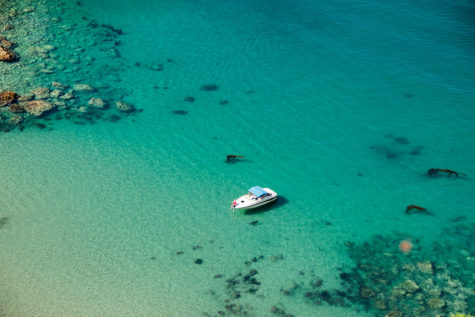 It’s embarrassing enough that it took me 12 years to go to Channel Islands National Park, especially since I see the islands almost every day. Last month, I got on board the dive boat that would take us to the place they call the Galapagos of North America. At last! The captain said something about Dramamine, but I didn’t really pay attention.
It’s embarrassing enough that it took me 12 years to go to Channel Islands National Park, especially since I see the islands almost every day. Last month, I got on board the dive boat that would take us to the place they call the Galapagos of North America. At last! The captain said something about Dramamine, but I didn’t really pay attention.
The trip takes about two and a half hours. After the first 30 minutes, I stood white-knuckled at the railing until the islands appeared. There were dolphins. I love dolphins! I hardly looked at these ones, even though there might have been three dozen of them. Instead I stared at the horizon as if it was an oncoming lifeboat.
When we finally anchored in a cove. I went downstairs to change into a wetsuit. Another passenger asked how I was doing. “Fine,” I said. Then I started losing my breakfast, and possibly the previous dinner as well. Later, once it was funny, my husband told me he was impressed with the force and the volume that I managed to vomit. At the time, he kindly got me a trashcan and brushed my hair away from my mouth.
I’d never gotten seasick before. It was kind of incredible, in the way that it’s incredible that the moving ocean beneath a boat can make you feel so awful. It’s incredible how jumbled you feel—and that’s really what’s happening, with your inner ear, your eyes, your skin, the proprioceptors that sense your position in space all trying to unscramble the shifting state of your surroundings.
People aren’t the only ones. The ponies that traveled on one of Ernest Shackleton’s Antarctic expeditions acted dizzy and confused as their boat rocked and rolled on the ocean. (The overpowering smell of puke was from the expeditioners, not the four-leggers, as horses can’t vomit.) Fish can get motion sickness, too: in one study of swordtail fish, researchers put their tanks through a number of oscillations, and three of the 23 shaken fish started to swim unusually.
When researchers analyzed ancient Greek and Roman writings, they found that suggested remedies for seasickness were much the same as what people advise today. Look at the horizon or to a fixed point on the coast. Use pleasant smells and medicinal plants, and spend more time at sea to acclimate yourself to the rise and fall of the waves. (The recommended concoction of wine and wormwood has not lasted through the ages—experts now suggest avoiding alcohol prior to a potentially rocky trip.)
Researchers have studied a number of medications to help with sea sickness; many of these have strong placebo effects. One captain recommends repeating “I don’t get seasick!” three times in a mirror before a trip. A year ago, LWON guest Elizabeth Svoboda wrote a lovely post about finding equanimity among the mental swells of seasickness.
I was well past the point of using affirmations or my inner calm to help myself by the time I emerged, still shaking, on deck. But after about thirty minutes in a kayak, my stomach settled. I even started to enjoy paddling into the steady rhythm of waves, and the booming sounds they made as they hit the inside of the sea caves.
On the smoother ride back to the mainland, I was amazed by how much better I felt. I found myself delighted over an ocean sunfish we spotted floating on the surface of the channel, and I almost cried when the cook gave me the lunch she’d been saving for me—it was the best meal I’d had in weeks.
I felt better still when the captain said it had been the roughest crossing all summer. And then he laughed. “In winter,” he said, “it can get twice as bad as that!”
**
Image by Chetan Kolluri via Flickr/Creative Commons license. This is what I thought the water was going to look like. I’ll have to go back.